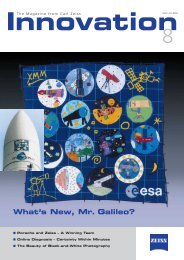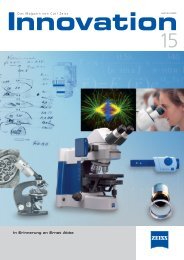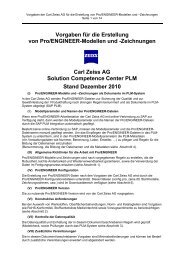Download PDF - Carl Zeiss
Download PDF - Carl Zeiss
Download PDF - Carl Zeiss
Create successful ePaper yourself
Turn your PDF publications into a flip-book with our unique Google optimized e-Paper software.
The Scourge of Back Pain –<br />
Treatment Methods and Innovations<br />
Fig. 1:<br />
The ergonomic design of<br />
the surgical microscope<br />
allows the surgeon to work<br />
in an extremely comfortable<br />
position over longer<br />
periods.<br />
38<br />
Back pain is among the most common<br />
health complaints in industrialized<br />
countries. More than 30<br />
million people in Germany alone<br />
suffer from chronic or occasional<br />
back pain – tense muscles in<br />
the neck and shoulder regions,<br />
pinched nerves or dislocated vertebra.<br />
Over the long term, spinal pain<br />
can considerably affect the quality<br />
of life, and not just the elderly<br />
suffer. Signs of wear on the spinal<br />
column can already be seen from<br />
the age of 30 and onwards. The<br />
rise in the number of patients<br />
with spinal pain and the simultaneous<br />
cost pressures in healthcare<br />
are leading to numerous innovations<br />
in treatment methods.<br />
<strong>Carl</strong> <strong>Zeiss</strong> recently discussed<br />
this with Dr. H. Michael Mayer,<br />
one of the leading spine surgeons<br />
and medical director at the Orthozentrum<br />
in Munich.<br />
Dr. Mayer, what developments<br />
and changes have you noticed in<br />
recent years concerning spine<br />
diseases?<br />
The range of spine diseases has<br />
changed so that now primarily older<br />
people have to undergo surgery on<br />
the spine. There are many different<br />
types of disease that occur mainly in<br />
old age, such as a narrowing of the<br />
spinal canal, degenerative scoliosis<br />
and constriction of the nerve canals.<br />
Increasing life expectancy has resulted<br />
in many more patients with symptoms<br />
of wear on the spine who<br />
require treatment and surgery than<br />
in the past.<br />
What is the significance of this<br />
rise in the number of patients for<br />
spinal surgery and what are the<br />
consequences?<br />
As a result of this development,<br />
spinal surgery is becoming more and<br />
more important, leading to a constant<br />
increase in the surgical possibilities.<br />
With new techniques, e. g. artificial<br />
discs or minimally invasive surgery,<br />
it is now possible to intervene<br />
at a much earlier stage with innovative<br />
methods that are designed to<br />
preserve the mobility and dynamics<br />
of the spine, particularly with symptoms<br />
of wear.<br />
Considering the cost pressures<br />
facing the healthcare sector, what<br />
opportunities and innovations are<br />
particularly important from your<br />
point of view?<br />
Any procedure that is considered<br />
minimally invasive is particularly important,<br />
i. e. all microsurgical and endoscopic<br />
procedures. In fact, we have<br />
been using minimally invasive methods<br />
in Germany for 15 years. However,<br />
it was only after healthcare reform<br />
that the positive effects had their full<br />
impact. Patients are released earlier<br />
from the hospital, i. e. the more gentle<br />
the operation, the shorter the stay<br />
and the faster the patient can be<br />
rehabilitated.<br />
What is required for minimally<br />
invasive surgery?<br />
There can be no minimally invasive<br />
surgery without visualization systems.<br />
Minimally invasive surgery is only<br />
possible if optical aids are available,<br />
e. g. a surgical microscope. Through<br />
tiny incisions, these instruments pro-<br />
1<br />
Innovation 15, <strong>Carl</strong> <strong>Zeiss</strong> AG, 2005
















